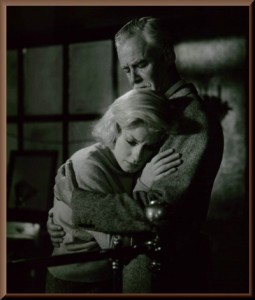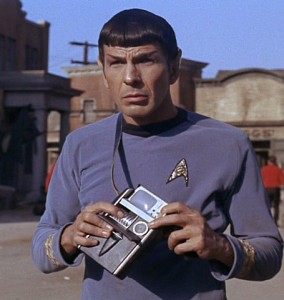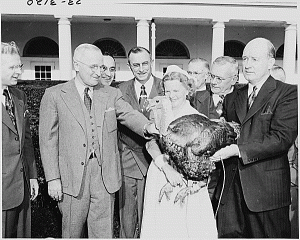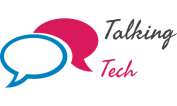by Bob | Jan 29, 2012 | Life notes, Local Tech Notes
For some odd reason I agreed to be in a play. I haven’t acted in a real play in many years. It’s less than 2 weeks to go before we open in Look Back in Anger at the Ferndale Repertory Theatre and I am still working on my lines! I am only in one scene. But I have a lot of lines in that scene. It’s been a real struggle for me. It may be age. It may be lack of practice with the specific skill of line memorization. But it may be that I rely on external sources to store and and provide instant retrieval of information so that the muscle of memorization of has atrophies.
I rely on my IPhone to remind me of tasks, appointments, birthdays, anniversaries. I have Google and Wikipedia to provide near instant facts and information that my old brain cannot possibly hold on to.
 I’m getting there, with lots of extra work and help from friends and family. But you never know. My brain still freezes at moments and lines I know simply disappear in the ether. So, you could come to the play just to see if I will crash and burn. Kind of like going to a NASCAR race. I may get by with a little paraphrase here and there but you wouldn’t know unless you have memorized the lines yourself. I might pull it off without a hitch. In which case, you might even enjoy the play for it’s own value. You’ll recognize me. I play the old guy.
I’m getting there, with lots of extra work and help from friends and family. But you never know. My brain still freezes at moments and lines I know simply disappear in the ether. So, you could come to the play just to see if I will crash and burn. Kind of like going to a NASCAR race. I may get by with a little paraphrase here and there but you wouldn’t know unless you have memorized the lines yourself. I might pull it off without a hitch. In which case, you might even enjoy the play for it’s own value. You’ll recognize me. I play the old guy.
by Bob | Jan 14, 2012 | Life notes, Local Tech Notes
This is a slightly edited and enhanced version of an article that appeared November, 2011 as part of the Times-Standard/Redwood Technology Consortium Tech Beat series.
The health industry in slowly adopting technology on a large scale, moving to electronic documents, computer generated prescriptions and information sharing. It’s been a rough road as standards and privacy issues have to be grappled with beyond the sheer technical problems. But the trade-offs in efficiency, accuracy and data gathering will be well worth the struggle. Mobile technology will play an increasing role in both institutional and personal health care advances.
An example of the convergence of data and mobile applications is the recent release of an IPad app for health practitioners by Practice Fusion a leader in electronic health records. The app allows doctors instant access to patient records in a secure environment from wherever they are as long as they are connected to the Internet.
While institutional adoption of mobile technology is starting to happen, another revolution in personal health monitoring is also taking place. An explosion of apps and add-on devices for mobile devices are putting a wealth of data gathering, sharing and eventually diagnosis in to the hands of ordinary people and health care workers in the field.
 There are quite a few tools already, though in many cases they are still rather basic. Most of the consumer apps and devices focus on diet and exercise monitoring. However, the future is bright as developers begin to understand the mobile platform and stretch its capabilities At the same time mobile systems continue to become more powerful and flexible. Additionally part of the delay of the release of more serious apps and devices has been the long approval process required by the Food and Drug Administration. However, according to a recent article in Business Week that process should soon be streamlined allowing for a flood of new advances for both health care workers and individuals.
There are quite a few tools already, though in many cases they are still rather basic. Most of the consumer apps and devices focus on diet and exercise monitoring. However, the future is bright as developers begin to understand the mobile platform and stretch its capabilities At the same time mobile systems continue to become more powerful and flexible. Additionally part of the delay of the release of more serious apps and devices has been the long approval process required by the Food and Drug Administration. However, according to a recent article in Business Week that process should soon be streamlined allowing for a flood of new advances for both health care workers and individuals.
A Few Current Applications and Devices
An example of the type of advanced app that can improve health care is described in an article on GigaOm. The app was developed by Dr. John Moore at the MIT Media Group:
One such app enables HIV patients at Boston Medical Center to visualize how HIV develops into AIDs, how the virus attacks their T cells and what happens if they do or do not take their cells. Using that app, he saw the percentage of patients sticking to their drug regime soar from 25 percent to 95 percent, Moss said.
Another application recently released is an ultrasound device that plugs in to a smartphone and allows a health worker to perform an on site scan.
My Medications, provided by the American Medical Association provides a convenient way for individuals to enter medical information such as allergies, prescriptions, and immunizations and to share that with primary care physicians.
AT&T recently released WellDoc Diabetes Manager that allows patients to monitor glucose levels and receive advice base on the input.
IBGStar is a blood glucose meter plug-in for the iPhone iPhone BGM plug-in will interact with a not yet Apple-approved iBGStar Diabetes Manager App that will help users track blood glucose, carbs intake and insulin dose.
In a more general consumer market, bluetooth phone device maker, Jawbone just came out with the UP, a wristband that monitors walking exercise, provides alerts for prolonged sedentary behavior (like sitting at your computer), monitors sleep habits and diet. The wristband is plugged in to the iPhone sound jack and the data is off-loaded to a free web app and can be shared on a social website.
ITriage is an iPhone/Android app that helps you answer the questions, “What medical condition could I have?” and “Where should I go for treatment?”
The Future is Near
It’s clear that we’re just at the beginning of this mobile revolution. In the next few years expect to see devices and apps become much

Live Long and Prosper
more sophisticated. Researchers are testing an MRI scanner attached to a smartphone that can detect cancer. And there is a 10 million dollar prize being offered for the development of a device that can scan a body and diagnose a variety of ailments. It’s called the Tricorder Prize, named after the device that Spock used in Star Trek. The future is coming fast. (FastCompany also has a good article on mobile health in the February print issue which I’ll link to if they put it online)
More Links
by Bob | Jan 2, 2012 | Life notes, Local Tech Notes
On our trip to the Olympic Peninsula in Washington I helped guide our way using my IPhone and the Google maps app. I was having fun watching our pin move along Highway 101, going around curves as we drove around the same curves. My wife said “Look out the window!” Oh, yeah – there’s Sequim Bay and lots of trees. “But look, this app is tracking our every move!” I said.
I have to admit I keep my nose stuck in too many screens. I guess Nick Bilton of the New York Times Bits Blog feels the same way. His New Year resolution is not to be quite so reflexive in grabbing a gadget to record and mediate his experiences.
I can relate, Nick. I may have to add this to my non-existence list of resolutions. So, now I have a list:
- Get more done
- Don’t be such a geek and look around
Who’s with me? Of course, then I wouldn’t be able to share this cool photo of the bay and Olympic Mountains:

Click to Enlarge Photo
by Bob | Jan 1, 2012 | Life notes

I think I started out the new year right, today. I got up early and after the frost melted, went for a long run in the early morning sun. I encountered this poor fellow who didn’t fair as well as I. His life, like so many has been cut short but I keep moving, grateful, at nearly 60 to have some more time to breath and be productive.
I have so many ideas and goals and projects in the hopper but I don’t want to make resolutions. I make them every day, anyway. Some I keep, some I don’t. They’re called to do lists. I’d maybe like to get more of each list done. So, that’s my one resolution. Get more done each day.
Not everything on my lists is work related after all: Do 2 lessons in learning Italian, write 2 pages of fiction, read the New Yorker and the Wall Street Journal, work an hour on personal web projects, work out for an hour. These are sometimes very hard to get to each day. There’s so much else that I let take priority. But looking at that raccoon makes me want to shift those priorities around. That’s the daily challenge.
by Bob | Nov 24, 2011 | Life notes, Local Tech Notes
In a world in which so many people have so little, I am truly thankful for my friends and family and that I have a warm home and plenty of food to share with them. I am also thankful for my health that allows me to enjoy, maybe even indulge a little in, these gifts.
But as this is a blog on technology, I am also thankful for these astounding technical innovations:
I am thankful for the Internet itself which has brought me many riches, culturally and financially.
I am thankful for my various iDevices (phone, pad) which have become essential parts of my work and play.
I am thankful for Twitter and even Facebook, and now also Google+ which all bring me so much delightful and sometimes outrageous information and connections with friends and strangers.
I am thankful for my cheap little Roku box which puts a bunch of new content on my big screen (for which I am also thankful).
This is just a small list, of course. But most of all, I am thankful to just still be here and to revel in the cool sunshine of this beautiful Fall day.
What are you thankful for?
by Bob | Nov 12, 2011 | Broadband/Internet, Life notes, Local Tech Notes
I am suddenly watching more TV or rather, video (TV shows, movies, Internet videos, etc.) over the Internet . I broke down and bought a Roku box the other  day. If you’re not familiar with the Roku, it’s one of several set top boxes that hook up to your TV, download or stream video from various sources and play them on your big screen. Some of the the other best known devices are Boxee and Apple TV (not the rumored Apple televisions set, but a box that hooks to your existing TV that Steve Jobs called a “hobby”).
day. If you’re not familiar with the Roku, it’s one of several set top boxes that hook up to your TV, download or stream video from various sources and play them on your big screen. Some of the the other best known devices are Boxee and Apple TV (not the rumored Apple televisions set, but a box that hooks to your existing TV that Steve Jobs called a “hobby”).
I bought the Roku because it’s the cheapest of the three and seems to have the most services available. I thought about getting an Apple TV because I am such an Apple fanboy and use ITunes quite a bit and the Apple TV has a built in integration with ITunes.
But the number of free sources on the Roku service won out. And if I subscribe to Netflix and HBOGO, I could have all the entertainment I could possible want. My goal is not necessarily to cut the chord on my cable service. But I wouldn’t mind cutting back to just basic cable. I’d need to have the service anyway if I wanted to get HBOGO.
I think all these devices are stop gap technologies that will soon be supplanted with something like the integrated television box (the rumored Apple TV, maybe), essentially a TV with a computer in it that connects directly to your ITunes and ICloud and has Siri in it so all you have to do is say “TV, show me cats playing  pianos and any unwatched episodes of Boardwalk Empire” and it wills show you a custom menu with a list of YouTube videos and unwatched episodes of Broadway Empire. And you will speak to it again, “Show me episode 16 of Broadway Empire” and it will start streaming that show. NO MORE REMOTES!
pianos and any unwatched episodes of Boardwalk Empire” and it wills show you a custom menu with a list of YouTube videos and unwatched episodes of Broadway Empire. And you will speak to it again, “Show me episode 16 of Broadway Empire” and it will start streaming that show. NO MORE REMOTES!
And eventually it will start to speak to you when you walk in the room and say in a soothing voice, “You have 3 unwatched episodes of Glee, Dave. Would you like to watch them now, Dave?” Even though my name is Bob and maybe that will be creepy.
But beyond that, Siri or something like it will be embedded in your house and appliances and we will be talking to the walls and the walls will talk to us as they learn our preferences and that really will be the moment we will all live in a technical cocoon, wrapped in silk threads of fiber.
 I’m getting there, with lots of extra work and help from friends and family. But you never know. My brain still freezes at moments and lines I know simply disappear in the ether. So, you could come to the play just to see if I will crash and burn. Kind of like going to a NASCAR race. I may get by with a little paraphrase here and there but you wouldn’t know unless you have memorized the lines yourself. I might pull it off without a hitch. In which case, you might even enjoy the play for it’s own value. You’ll recognize me. I play the old guy.
I’m getting there, with lots of extra work and help from friends and family. But you never know. My brain still freezes at moments and lines I know simply disappear in the ether. So, you could come to the play just to see if I will crash and burn. Kind of like going to a NASCAR race. I may get by with a little paraphrase here and there but you wouldn’t know unless you have memorized the lines yourself. I might pull it off without a hitch. In which case, you might even enjoy the play for it’s own value. You’ll recognize me. I play the old guy.





 day. If you’re not familiar with the Roku, it’s one of several set top boxes that hook up to your TV, download or stream video from various sources and play them on your big screen. Some of the the other best known devices are
day. If you’re not familiar with the Roku, it’s one of several set top boxes that hook up to your TV, download or stream video from various sources and play them on your big screen. Some of the the other best known devices are